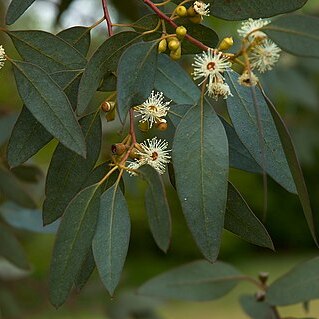Tree to c. 10 m high; bark rough and sometimes persistent at base, otherwise trunk smooth and grey. Juvenile lvs opposite for many pairs, sessile, very glaucous, suborbicular to broad-ovate; base cordate; apex obtuse or acute. Adult lvs with petioles 1-2.5 cm long; lamina 4-10 × 1-2.5 cm, oblong-lanceolate or oblong-elliptic, subcoriaceous, green or ± glaucous, concolorous; lateral veins diverging at c. 45° to midrib; base symmetric; apex usually acute or mucronate. Fls axillary, in clusters of 3; peduncles 5-10 mm long, flattened; pedicels short. Buds 7-8 mm long, ± clavate, glaucous; operculum hemispheric, much < hypanthium. Stamens white; anthers oblong. Fr. shortly pedicellate, 5-9 × c. 6 mm, cylindric-urceolate, with truncate apex, glaucous; valves 4, deeply sunken; disc narrow, descending.
A tree which grows to 18-25 m high. It spreads to 6-12 m across. It keeps its leaves year round. The bark is thin and smooth and reddish. It peels off in flakes. The young leaves occur in pairs and almost circle the stem. The young leaves are rounded and blue and these are replaced by sickle shaped grey-green leaves. The leaves are 7.5-10 cm long. The bark becomes green-white and this is shed to reveal new grey-green bark. The flowers are cream-white and occur in clusters or three. They have a hinged lid which opens to allow insect pollination. The fruit are small and urn shaped.


